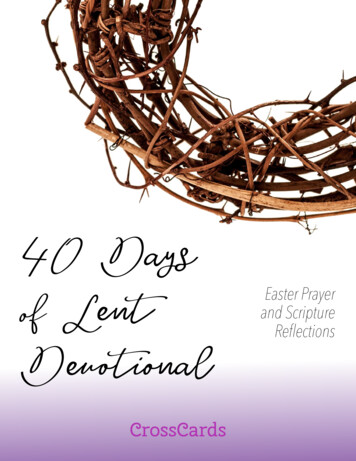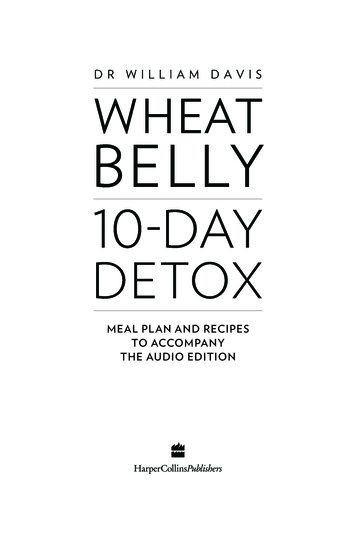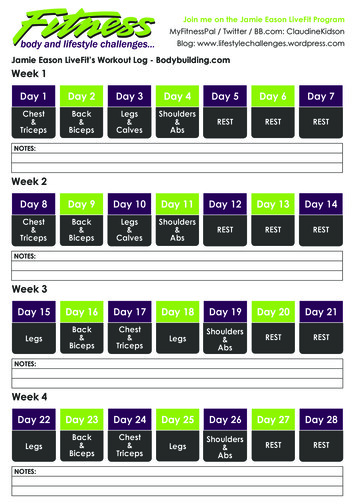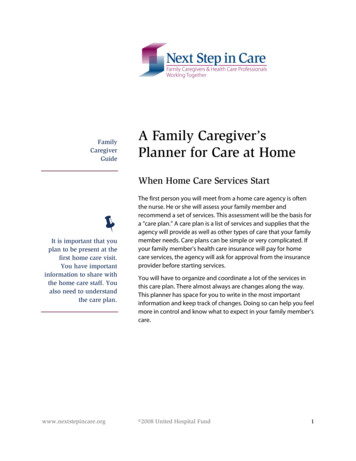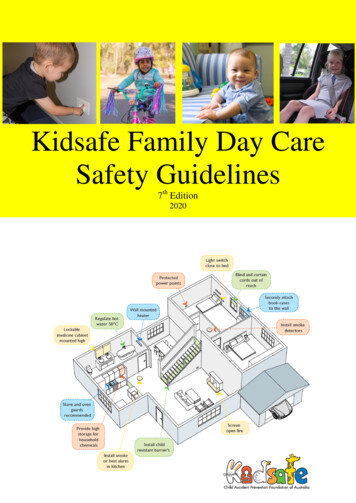
Transcription
Kidsafe Family Day CareSafety Guidelines7th Edition2020
Kidsafe Family Day CareSafety Guidelines2020Kidsafe NSW on behalf of Kidsafe Australia has prepared this 7th edition of the Family Day Care Safety Guidelines.First published in 1986. We acknowledge the Aboriginal peoples as the first inhabitants of Australiaand the traditional custodians of the Country on which we live, learn, work and play.We pay respects to their Elders past, present and future. For further information regarding these Safety Guidelines, contact Kidsafe in your state or territory:www.kidsafe.com.auACTTASQLDSA(02) 6290 22440417 381 721(07) 3854 1829(08) 8161 6318NSWNTVICWA(02) 9845 0890(08) 8941 8234(03) 9036 2306(08) 6244 4880You are free to download and copy the Safety Guidelines for use in Family Day Care Services.www.kidsafe.com.auCopies must not be offered for sale or published elsewhere.ISBN 0 949 630 24 1DisclaimerThe Kidsafe Family Day Care Safety Guidelines has been prepared from information available to Kidsafe Australia – the ChildAccident Prevention Foundation of Australia (CAPFA) at the time of preparation. This document is aimed at supporting earlychildhood educators to prevent unintentional injury to children by identifying potential risks and hazards in the Family Day Care(FDC) environment.Whilst care has been taken to ensure the accuracy of the information provided, Kidsafe Australia takes no responsibility for anyerrors, omissions or changes to information that may occur, and disclaims all responsibility and liability to any person for anyactions taken or not taken because of the information within these Guidelines.This document is a guide only, not regulation. It does not override state or territory legislation or regulations, national standards orservice policies (where applicable).Individual state and territory legislation and safety guidelines must be consulted in relation to particular standards or requirements,as these vary across Australia. Where applicable, national standards have been included throughout the document.These Safety Guidelines are of a general nature and may not address issues relevant in particular circumstances. Family Day Careservices and coordinators should seek their own legal and professional advice to ensure compliance with relevant laws andstandards.Kidsafe Family Day Care Safety Guidelines 20201
CONTENTSAcknowledgements . 3Commendations . 4SECTION ONE – Overview . 5Introduction . 5Australian Standards. 5Aim . 6Purpose . 6Definitions . 8SECTION TWO – Risk and safety management . 9Part 1 - Risk and safety management . 9Part 2 – Drowning . 13Part 3 – Falls, slips and trips. 17Part 4 – Burns and scalds . 26Part 5 – Lacerations, cuts and crushing . 31Part 6 – Poisoning. 34Part 7 – Other injuries . 36Part 8 – Road safety. 41SECTION THREE – References, resources, contacts and Australian Standard . 46SECTION FOUR – Hazard reduction checklist. 60Kidsafe Family Day Care Safety Guidelines 20202
AcknowledgementsKidsafe Australia is grateful to staff and their expert advisors from state and territory Kidsafe offices for their supportand expertise in the updating of the Family Day Care Safety Guidelines.Kidsafe Australia would also like to acknowledge the expert advice provided by the following people as part of thereview process for the 7th Edition.NamePositionOrganisationScott RollasonGeneral ManagerFamily Day Care Australia Inc.Michael FarrellNational Policy and Advocacy ManagerFamily Day Care Australia Inc.Perry CampbellDeputy National Education LeaderAustralian Children’s Education & CareQuality Authority (ACECQA)Nicky SpaldingConsultantNSW Family Day Care Association Inc.Anita JovanovskiChief Executive OfficerNSW Family Day Care Association Inc.Katrin KlingerSenior AssociateCollard Maxwell Architects Pty LimitedSiobhan ConnollyBurns Prevention Officer/Education OfficerNSW Severe Burns Injury Service , NSWHealth DepartmentSuzanne WicksDepartment HeadKids Health Child Health PromotionUnit, SCHN, NSW Health DepartmentJason De BakkerChief Executive OfficerFamily Day Care Association QueenslandKym GrothSector Development and Relations ManagerFamily Day Care Association QueenslandRobert BlinRisk and Quality ManagerFamily Day Care Association QueenslandKidsafe Family Day Care Safety Guidelines 20203
CommendationsOn behalf of Family Day Care Australia, I commend Kidsafe on their ongoing commitment to the safety ofchildren across Australia and, through this valuable resource, in family day care services. Child safety isparamount. We share a commitment to ensuring that child safety is at the forefront of educators' practiceand it is through evidence-based resources like this that this endeavour is strengthened.Andrew Paterson, CEO, Family Day Care AustraliaKeeping children safe is of critical importance and the Family Day Care Safety Guidelines are an integralpart in ensuring the safety of our children. The Safety Guidelines are an important part of ourcommitment to child safety and advocating for best practices on behalf of the youngest members of oursociety. This is an initiative that Kidsafe is extremely proud to provide, and are honoured to have beenable to serve the community in this way since 1986 right up to the present day with this latestpublication.Craig Ray, President, Kidsafe AustraliaKidsafe Family Day Care Safety Guidelines 20204
SECTION ONE – OverviewSECTION ONE – OverviewIntroductionInjury is a major health problem for Australian children. Each year approximately 150 children dieas a result of injury.1 For every one child that dies, a further 450 will be hospitalised. Many of thesewill require ongoing medical care. About one-third of the children injured are younger than fiveyears old and half of these injuries occur at home.2In 2019, Kidsafe Australia celebrated 40 years of making a safer world for kids! In 1979, childinjury death rates for 0-14 year olds were about 650 per year, in the most recent data available,these now sit at about 150 per year. While the reduction of these deaths is a great achievement,there is still more to be done.Many of these unintentional deaths and injuries are avoidable and can either be prevented or injuryminimised.Putting simple preventative strategies in place can reduce thelikelihood and severity of injury.Kidsafe Australia developed these national Safety Guidelines, to support the prevention ofunintentional child injury in home-based education and care services such as Family Day Care.Kidsafe Australia is a national non-profit organisation dedicated to the prevention of unintentionalchildhood injuries and reducing the severity of unintentional injuries to children under the age of 15years. Its aim of a safer world for children is achieved through community education, research,advocacy, and environmental and legislative change.Australian StandardsThroughout the Safety Guidelines, Australian Standards are referenced to assist agencies andservice providers locate recommended safety measures and specifications.Relevant and applicable Australian Standards are listed at the beginning of each risk area outlined inSection Two. Information can also be found in Section Three - References, resources, contacts andAustralian Standards. This is not an exhaustive list, and it is recommended that Family Day Carecoordinators and educators routinely check with their local regulatory authority regarding relevantAustralian Standards.Standards establish a common language so that consumers can buy products and services knowingthat experts have assessed them and are safe and reliable.Kidsafe Family Day Care Safety Guidelines 20205
SECTION ONE – Overview“Australian Standards are published documents setting out specifications and procedures designedto ensure products, services and systems are safe, reliable and consistently perform the way theyare intended to. They establish a minimum set of requirements which define quality and safetycriteria. Australian Standards are voluntary documents that are developed by consensus. ManyAustralian Standards, because of their rigour, are adopted into legislation to become mandatory orreferenced in contracts.”3AimThe aim of these Safety Guidelines is to support home-based education and care services to: establish a level of safety for the approved Family Day Care venue identify potential hazards so that they can be managed to reduce the risk of unintentionalinjury to children.The Safety Guidelines are designed to be used as a tool to help create a safer environment forchildren by: identifying a number of potential risk areas specifying information on minimum safety requirements and legislation providing suggestions on how to deal with the risk giving additional resources and contact details supplying a comprehensive checklist to identify and reduce hazards in and around theFamily Day Care venue.PurposeFamily Day Care coordinators and educators can use this information as part of their overallprogram. The Safety Guidelines focus on the age group of children most at risk – those underschool age. Educators will need to consider adjustments for school-age children regarding ageappropriate toys, supervision levels and playground and safety equipment.It is recommended that Family Day Care coordinators and educators:1.Participate in regular professional development.2.Routinely check variations or additional requirements.Local variations must be checked with the relevant regulatoryauthority in each state and territory.3.Discuss the areas outlined in Section Two during the home assessment.4.Complete the hazard reduction checklist, provided in Section Four.Kidsafe Family Day Care Safety Guidelines 20206
SECTION ONE – OverviewThe approved Family Day Care venue is assessed annually or asrequired by the relevant regulatory authority.REMEMBER: Family Day Care coordinators play an important role in supporting educators tounderstand child safety needs. Therefore it is recommended that coordinators: make explanations clear reinforce any positive steps in managing child safety encourage educators to be vigilant in recognising and treating potential hazards asthey arise support educators to participate in training workshops that are tailored to specificneeds have detailed discussions with educators about the content and aims of the SafetyGuidelines, emphasising the following points:- the hazard reduction checklists provide an opportunity to examine any actual orpotential hazards in the Family Day Care venue and property- the hazards should be dealt with as they arise, and a time frame established toensure that they are addressed promptly.Ensure the service’s policies and procedures clearly outline practices thatsupport children’s safety.Kidsafe Family Day Care Safety Guidelines 20207
SECTION ONE – OverviewDefinitionsSome of the specific terms used throughout the Safety Guidelines are defined as follows:Barriers*Challenge Supervised earlychildhood service(SECS)*Domestic trampoline**Entrapment*Falling space*Free height of fall*Free space*Hazard Impact area*Impact attenuatingsurface**Risk assessment*Risk benefit assessment*Supervision†Young child††A device intended to prevent the user from falling and from passingbeneath.Situations that allow risks without undue danger of serious harm.A defined playspace used by an education and care service orchildren’s services, for children under school aged, which issupervised by educators.A rebound-jumping device that is greater than 360mm from the groundsurface and has a bed surface less than 1m2.A hazard presented by the situation in which a body, or part of a body,or clothing can become trapped.The space in, on or around the equipment that can be passed throughby a user falling from an elevated part of the equipment.The greatest vertical distance from the point of clearly intended bodysupport to the impact area below.The space in, on or around the equipment that can be occupied by auser undergoing a movement forced by the equipment (e.g. sliding,swinging, rocking).Something, including a person’s behaviour which has the potential tocause death, injury or illness.The area that can be hit by a user after falling through the fallingspace.A material designed and tested to the Australian Standard (AS 4422),installed in impact area to minimise the impact of falls and reduce therisk of head or other serious injuries.The identification, evaluation, and estimation of the levels of risksinvolved in a situation and the likelihood of its occurrence, itscomparison against benchmarks or standards, and determination of anacceptable level of risk.A tool to aid risk management that explicitly brings togetherconsideration of the benefits as well as the risks of play in a singlejudgement.An adult constantly observing and relating to children as to respondimmediately including when a child is distressed or is in a hazardoussituation.Refers to babies, toddlers and three to five year olds, unless otherwisestated.* Definition taken from AS 4685** Definition adapted from AS 4685 Definition adapted from Play England† Definition adapted from Victoria Government††Definition taken from Australian Government Definition taken from Safe Work AustraliaKidsafe Family Day Care Safety Guidelines 20208
SECTION TWO – Risk and safety managementSECTION TWO – Risk and safety management1. Risk and safety managementIt is good practice for Family Day Care educators to conduct environmental risk assessmentson a daily basis. Risk assessments of activities and excursions are also required.Educators will be guided by service policies and procedures and advised bystaff at their Family Day Care service.The hazard reduction checklist (Section Four) is part of our risk management approach tochild safety. It is a useful tool for helping to identify and analyse potential risks, and to decideon the best type of treatment. Ongoing review is essential to ensure the risk treatment is themost appropriate action.The risk level matrix below is a simple, but effective way of helping to categorise andprioritise potential risks and their treatment. Different risks require different levels of eenGreen(Adapted from SA/SNZ HB 89)Risk treatment keyRedImmediate actionAmberHeightened actionGreenBusiness as usualUsing the table above, for example, if the consequence is ‘major’ and the likelihood is‘likely’, then the response level is ‘red’ indicating that immediate action needs to be taken;similarly, if the consequence is ‘moderate’, but the likelihood is ‘likely’, then the response isalso red. Alternatively, if the consequence is ‘minor’ and the likelihood is ‘unlikely’, then theresponse is ‘green’, which indicates that a business as usual approach may be sufficient.Risk management approach deals with potential safety hazards. This approach is adapted fromthe risk management process as outlined in AS/NZS ISO 31000: Risk management Guidelines.Kidsafe Family Day Care Safety Guidelines 20209
SECTION TWO – Risk and safety managementRisk management does not require the automatic removal of all risks. Risk benefitassessment is frequently a more appropriate method of assessment.Family Day Care services and educators can develop an approach to risk management thatconsiders the benefits as well as the risks. A degree of risk can be beneficial in play.Providing children with the opportunity to enjoy challenging, adventurous play, encounteringhazards and taking risks will assist in their development and support their capacity to managerisks for themselves.1.1. Safety managementAustralian StandardsFor further information, see Section Three of these Safety Guidelines.Australian StandardsReferenceTitleArea coveredHB 46-2010Fire Safety in the HomeAS 3786:2014*Smoke alarms using scattered light, transmittedlight or ionizationFire prevention andmanagementAS/NZS 1841.1:2007*Portable fire extinguishers, Part 1: GeneralrequirementsAS/NZS 3661.2: 1994*Slip resistance of pedestrian surfaces – Guide tothe reduction of slip hazardsGeneral: slip hazardsISO/IEC Guide 50:2014Safety aspects – Guidelines for child safetyChild safetyAS 4226:2008Guidelines for safe housing designSafe housing designAS/NZS ISO 31000:2018Risk management- GuidelinesSA/SNZ HB 89:2013Risk management – Guidelines on riskassessment techniquesGeneral risk managementpracticeHB 266:2010Guide for managing risks in not-for-profitorganisationsOther Regulatory DocumentsNational Construction Code (NCC) of Australia*Mandatory Australian Standard1.1.1. First aidFamily Day Care educators and assistants must: hold a current approved first aid and CPR qualification undertake current approved anaphylaxis and emergency asthmamanagement training have a suitably equipped, easily recognisable and readily accessible first aidkit, available only to adults wherever an educator is educating and caring forchildren display a resuscitation chart in a prominent position.Kidsafe Family Day Care Safety Guidelines 202010
SECTION TWO – Risk and safety management1.1.2. CommunicationsApproved Family Day Care venues must have ready access to an operating telephoneor other similar means of communication.A list of the following emergency numbers must be placed next to the telephoneand/or in a prominent place (see the sample given below):o 000 – Ambulance, Fire Brigade, Policeo 13 14 44 –Police Assistance Line (Nationwide)o 13 11 26 – Poisons Information Centreo Nearest hospitalEMERGENCY NUMBERS (Sample)Ambulance:000Fire Brigade:000Police:000Poisons Information Centre:13 11 26FDC Service:Nearest Hospital:1.1.3. Emergency proceduresAll educators must conduct a risk assessment to identify hazards. This will inform thewritten evacuation procedure and floor plan in consultation with a coordinator fromtheir service. The plan must be displayed at each exit and evacuation procedurepractised every three months and appropriately documented as per the NationalRegulations.1.1.4. Fire prevention and managementEducators should check the Australian Standard, The National Construction Code(NCC) and relevant state or territory regulations. Fire extinguishers and blankets mustbe checked every six months by recognised authorities. Smoke detectors are mandatory for all homes. They must meet the Standardand must be checked regularly to ensure that they are operational (refer to AS3786) and be positioned according to the requirements of The NationalConstruction Code (NCC).Kidsafe Family Day Care Safety Guidelines 202011
SECTION TWO – Risk and safety management Fire blankets should be installed in the kitchen area and educators should befamiliar with how to use it in the event of a fire.Fire extinguishers should be installed in homes and maintained as required(refer to AS 1841.1).Regularly check andmaintain smoke detectorsKidsafe Family Day Care Safety Guidelines 202012
SECTION TWO – Risk and safety managementPart 2 – DrowningDrowning is one of the major causes of unintentional death for children aged 0-4 years. Thereare eight non-fatal drowning events for each toddler drowning death.4 According to the RoyalLife Saving Society of Australia an annual average of 30 drowning deaths5 of children aged 04 years occur in swimming pools, and 5 drowning deaths of children aged 0-4 years inbathtubs/spa baths.6Although home swimming pools are the most common site for drowning, young children candrown in just a few centimetres of water. Common items such as buckets, pots, water tanks,water features, water troughs, water play equipment, fishponds, or even a pet’s water bowl areall potential hazards for young children.It takes only a few seconds for a child to drown.Adult supervision of young children in, on, or around water must beconstant.Relevant Australian Standards and Regulations:There are a range of Standards that can help with safety around pools. For further information,see Section Three of these Safety Guidelines.Australian StandardReferenceTitleAS 1926 Set-2012*Includes:Swimming pool safety Standards SetAS 1926.1-2012*Swimming pool safety - Safety barriers forswimming poolsAS 1926.2-2007*Swimming pool safety - Location of safety barriersfor swimming poolsAS 1926.3-2010*Swimming pool safety - Water recirculationsystemsAS 2610.2-2007(R2016)Spa pools – Private spasAS 3861-1991 (R2016)Spa bathsArea coveredPools and spas*Mandatory Australian Standard2.1. Pools, spas, paddling pools and inflatable pools that can be filled tomore than 300mm of waterLegal requirements for pools, spas, paddling pools and inflatable pools vary acrossAustralia. It is very important to check with your local council and regulatory authority.National safety standards requirements include: enclosing swimming pools with an isolation barrier that complies with theAustralian StandardKidsafe Family Day Care Safety Guidelines 202013
SECTION TWO – Risk and safety management enclosing paddling pools and inflatable pools that can be filled to more than300mm of water with an isolation barrier that complies with the AustralianStandardmaking spas inaccessible with a locked pool cover when not in use or anisolation barrier with a self-closing and self-locking gate (AS 2610.2).Isolation barriers should be at least 1.2m high and without footholds thatwould allow a young child to climb overensuring boundary barriers that form part of the pool barrier, must be at least1.8m highconfirming that gates are self-closing, self-latching and have a child-resistantlocknot allowing direct access from the house to the poolImage source: Kids Health at The Sydney Children’s Hospital Network never propping pool gates open, always keeping the gate closedensuring any doors that form part of the pool barrier have a self-closingmechanism and a child-resistant lockrestricting windows that form part of the pool or spa barrier from openingmore than 100mmensuring a Non-Climbable Zone (NCZ) (on the outside of the pool barrier) ofat least 900mmremoving objects that could help a child to climb over a fence or open a gate,door or window. This includes furniture and climbable plants or shrubsgrowing on the pool fenceremoving the ladder from above-ground pools and store safely when not in usedisplaying a resuscitation chart prominently within the pool areamaking pool filters inaccessible to children.Kidsafe Family Day Care Safety Guidelines 202014
SECTION TWO – Risk and safety management2.2. BathtubsEducators may have reason to use a bathtub with Family Day Care children, such as a childwho is in 24-hour care. In this case, educators should ensure they: maintain constant supervision remain within arm’s reach of children at all times empty water immediately after use.2.3. Water featuresWater features such as ponds, wells and holes (see Figure 1) should be: completely covered by a solid material which is secured in position and cansupport the weight of an adult designed to prevent a child putting their face into the water such as installinglarge rocks/boulders that will significantly reduce the depth of waterOR completely enclosed by a barrier, such as a fence, wall, gate or door.Figure 1: Water features and pond safety2.4. Creeks, rivers, dams and natural pondsHome-based education and care services that are adjacent to, or provide access to, bodiesof water such as creeks, rivers or dams should have: a barrier, such as a fence or wall, which separates the property from that bodyof water to allow for a safe play area.2.5. Plumbing fixtures and appliancesWhere there are rooms, areas or cupboards that have a basin, tub, washing machine orsimilar plumbing fixture or appliance, it is recommended to: securely enclose the area with doors or gates that have child-resistant catches store plugs (e.g. bath plugs) out of reach of young children.Kidsafe Family Day Care Safety Guidelines 202015
SECTION TWO – Risk and safety management2.6. Water containersStore or enclose any moveable water container such as a nappy bucket, animal drinkingbowl and paddling pool out of reach of young children.Kidsafe Family Day Care Safety Guidelines 202016
SECTION TWO – Risk and safety managementPart 3 – Falls, slips and tripsFalls are the most common cause of injuries to children less than five years, with the majoritybeing head injuries and fractures. Any of the following examples could provide a potentialrisk: slippery/uneven floors unsecured rugs protruding/climbable furniture stairs change tables cots highchairs play equipment trampolines beds and bunk beds bathtubs and spa baths windows and balconies.Australian Standards:For further information, see Section Three of these Safety Guidelines.Australian StandardReferenceTitleArea coveredAS 4226:2008Guidelines for safe housing designStairs and balustradesAS 4586-2013*Slip resistance classification of new pedestriansurface materialsAS 4685 (Set):2014Playground equipment and surfacing safety setThis set includes the following titles:AS 4685.0:2017 AS 4685.1:2014 AS 4685.2:2014 AS 4685.3:2014 AS 4685.4:2014 Playground equipment and surfacing Development, installation, inspection,maintenance and operationPlayground equipment and surfacing General safety requirements and testmethods (EN 1176-1:2008, MOD)Play equipmentHeight of equipmentPlayground maintenance andsafe playPlayground equipment and surfacing Additional specific safety requirementsand test methods for swings (EN 11762:2008, MOD)Playground equipment and surfacing Additional specific safety requirementsand test methods for slides (EN 11763:2008, MOD)Playground equipment and surfacing Additional specific safety requirementsand test methods for cableways (EN1176-4:2008, MOD)Kidsafe Family Day Care Safety Guidelines 202017
SECTION TWO – Risk and safety managementAS 4685.5:2014 AS 4685.6:2014 Playground equipment and surfacing Additional specific safety requirementsand test methods for carousels (EN 11765:2008, MOD)Playground equipment and surfacing Additional specific safety requirementsand test methods for rocking equipmentAS 4422:2016Playground surfacing – Specifications,requirements and test methodFalling space and impact areaPlayground surfacingAS/NZS 8124 Part 6(ISO 8124-4:2014,MOD) *Safety of toys - Swings, slides and similar activitytoys for indoor and outdoor family domestic useSwings, slides, toysAS 4685.2:2014Playground equipment and surfacing – additionalspecific safety requirements and test methods forswingsSwingsAS 4989:2015Trampolines for domestic use – Safety aspectsTrampolinesAS/NZS 2088:2013*Prams and strollers – Safety requirementsFurniture and furnishingsAS/NZS 2172:2013*Cots for household use – Safety requirementsAS/NZS 2195:2010*Folding cots – Safety requirementsAS/NZS 8811.1-2013Methods of testing infant products - Method 1:Sleep surfaces - Test for firmnessAS/NZS 4220:2010*Bunk beds and other elevated bedsAS 4684-2009High chairs - Safety requirementsAS/NZS 2063-2008*Bicycle helmetsBicycle and wheeled toysOther Regulatory DocumentsNational Construction Code (NCC) of Australia D2.24National Construction Code (NCC) of Australia Part 3.9*Mandatory Australian Standard3.1. Trenches and excavationsAny trench or excavation should be: completely covered by a solid material which is secured in position andcapable of supporting the weight of an adult, OR completely closed by a barrier, such as a fence, wall or door.3.2. Stairs and balustradesThe design of stairs and balustrades should be in accordance with relevant codes orstandards, including the National Construction Code (NCC) of Australia.The NCC requirements include (see Figure 2): securing stairways, ramps, corridors, hallways, external access balconies orbridges, with one or more sides, 1m or more above the floor or ground, withbarriers ensuring walls or balustrades:o are at least 865mm above the front edge of stair treadsKidsafe Family Day Care Safety Guidelines 202018
SECTION TWO – Risk and safety management o are at least 1m above a level floor surfaceo do not have ho
Kidsafe Family Day Care Safety Guidelines 2020 4 On behalf of Family Day Care Australia, I commend Kidsafe on their ongoing commitment to the safety of children across Australia and, through this valuabl

![Welcome [dashdiet.me]](/img/17/30-day-weight-loss-journal.jpg)
